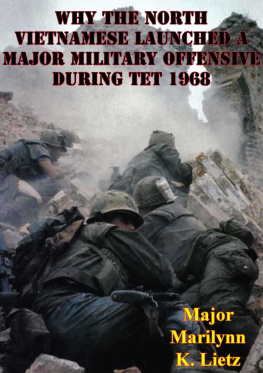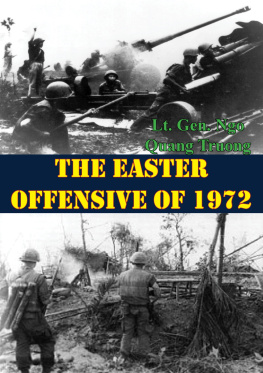This edition is published by PICKLE PARTNERS PUBLISHINGwww.picklepartnerspublishing.com
To join our mailing list for new titles or for issues with our books picklepublishing@gmail.com
Or on Facebook
Text originally published in 1991 under the same title.
Pickle Partners Publishing 2014, all rights reserved. No part of this publication may be reproduced, stored in a retrieval system or transmitted by any means, electrical, mechanical or otherwise without the written permission of the copyright holder.
Publishers Note
Although in most cases we have retained the Authors original spelling and grammar to authentically reproduce the work of the Author and the original intent of such material, some additional notes and clarifications have been added for the modern readers benefit.
We have also made every effort to include all maps and illustrations of the original edition the limitations of formatting do not allow of including larger maps, we will upload as many of these maps as possible.
WHY THE NORTH VIETNAMESE LAUNCHED A MAJOR MILITARY OFFENSIVE DURING TET 1968
By
MAJ M.K. Lietz, USA.
TABLE OF CONTENTS
Contents
ABSTRACT
This study examines the reasons why the North Vietnamese launched a general offensive during the Tet holiday of 1968. Based on events of the previous year, conditions did not appear favorable for the North Vietnamese to undertake such a massive and risky operation. Several reasons accounted for this decision; political pressure from Russia and China for a resolution to the war, military failure to achieve victory through the use of the dau tranh strategy of war, the increasing inability of the Vietnamese people-North and South-to provide economic and social support for the war, and impatience on the part of the North Vietnamese leaders. North Vietnams goal was to hasten the resolution of the war by a massive offensive and to quickly bring the United States and South Vietnam to the negotiating table. By prematurely launching this offensive, the North Vietnamese did not comply with the dau tranh model strategy of revolutionary war.
ACKNOWLEDGMENTS
I extend my gratitude to Colonel V. Paul Baerman, Committee Chairman, to Colonel Robert W. Duffner, Consulting Faculty Member, and to Lieutenant Colonel Ralph K. Bodenner and Major Butch B. Baker, both members of my committee, without whose generous guidance I could not have completed this thesis. I also wish to thank my Mom and Dad for wholeheartedly supporting my endeavors for the past 36 years.
M. K. L.
CHAPTER ONE INTRODUCTION
We make war in the Vietnamese manner.... A Soviet Marshal once asked me how I defeated the Americans. He asked me how many infantry divisions, tank divisions, artillery divisions we had. How much aviation [laughter]. If we had fought like that, we would have been beaten in less than two hours, but we fought differently and we won. Senior General Vo Nguyen Giap, 1990
Purpose
This research paper will explain why the North Vietnamese thought January 1968 was the correct time to launch a major offensive. It will also analyze why that decision was an incorrect one based on the protracted war model of Mao Tse-Tung, as applied to the more specific Vietnamese strategy for revolutionary war.
Context of the Problem
It is widely thought the North Vietnamese offensive of Tet 1968 was the turning point in the Vietnam war. In order to understand why this offensive occurred when it did, the reader requires some background of Vietnam and its leaders.
Prior to the United States intervention in the 1960s, Vietnam had struggled against outside aggression for over two thousand years. In the mid-nineteenth century the French began a policy to colonize Vietnam, Cambodia, and Laos into French Indochina. Since the 1920s there were groups of communists and nationalists in Indochina who opposed the French. Both groups wanted to control the country, but above all, they wanted Vietnam ruled by Vietnamese people, not colonialists.
In an interview with a western journalist in 1990, Senior General Vo Nguyen Giap discussed why the Vietnamese people turned to communism during the French occupation. Giap, a revolutionist since 1926 and one of the key developers of the Vietnamese strategy for revolutionary war, believed development of an organized communist party resulted from French repression.
According to the French Supreme Command, Far Easts Lessons learned from the Indochina War, Volume II, the French also pinpointed the beginning of the communist insurgency in Vietnam as response to their forceful military actions against the depression-caused peasant unrest in North-Annam (northern part of what is now South Vietnam) and in the Tonkin Delta area (North Vietnam) in 1930. For example, a village shelled by the French in retaliation for peasant unrest remained a hotbed of peasant revolt.
According to Douglas Pike, author and noted expert on the Vietnamese army and culture, the French reprisal was a result of the communist movement replacing the officials in sixteen villages with communist leaders. The communists planned to use these leaders as the nucleus for revolution. The 1930 peasant uprisings in Annams Nghe An and Ha Tin provinces spread to revolts and, for a brief time, were national in scale. The French swiftly retaliated and through systematic, direct military action, removed the village communist leaders and put down the rebellion. In all, 10,000 Vietnamese were killed, 50,000 exiled, and 100,000 jailed by the French.
In response to this French action, the Vietnamese officially formed the Indochinese Communist Party (ICP) in October 1930. The partys policy summary was written in absentia by ICP leader Ho Chi Minh residing in Hong Kong.
When the Japanese occupied Indochina in 19.40, they left the French colonial administration intact, but controlled its actions.
As discussed by Thomas Latimer in his doctorate thesis on Hanois Leaders and their South Vietnam Policies, Ho was exposed to many different cultures through his travels. He started his wanderings as a mess boy aboard a French freighter in 1911. During his thirty years roaming outside Vietnam, he traveled for the Communist party as a revolutionist, serving everywhere the party needed an experienced and able revolutionary, gaining political but not military experience.
Ho and his Indochinese Communist Party were determined to expel the French and Japanese forces that occupied Vietnam. After France fell to Germany on the European continent during World War II in June 1940, Ho Chi Minh began to discuss strategy within the ICP. He felt political action should have primacy in the revolution process. Remembering the disastrous results of direct political action taken by the ICP during the 1930 depression, Ho still wanted to resolve differences with political action before trying to force the issue with military action. He knew his military arm of power, under the leadership of Giap, was still not strong enough to overthrow the Japanese military in Vietnam. Its arms and ammunition were outdated. Some were captured from the French, others from Chaing Kai-sheks army of China. Therefore, his strategy was political action should precede military action.
However, in February 1941 after Ho returned to Vietnam from China, he made plans to conduct armed military struggle against the French and Japanese occupation forces. During the Indochinese Communist Partys Eighth Plenum (general assembly) held in Kwangsi, China, in May 1941, the ICP officially decided that armed dau tranh (struggle) would be conducted through a united front.









